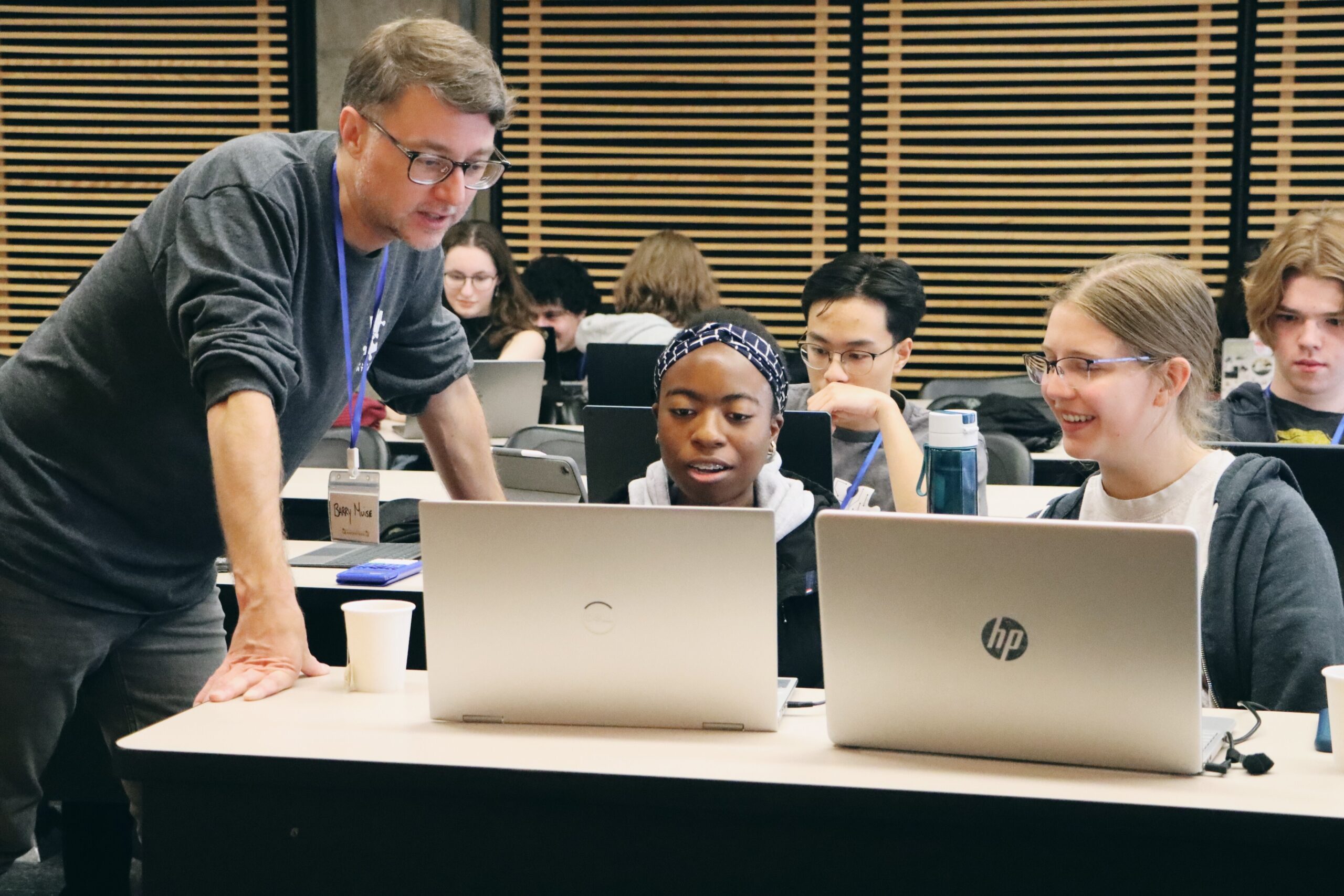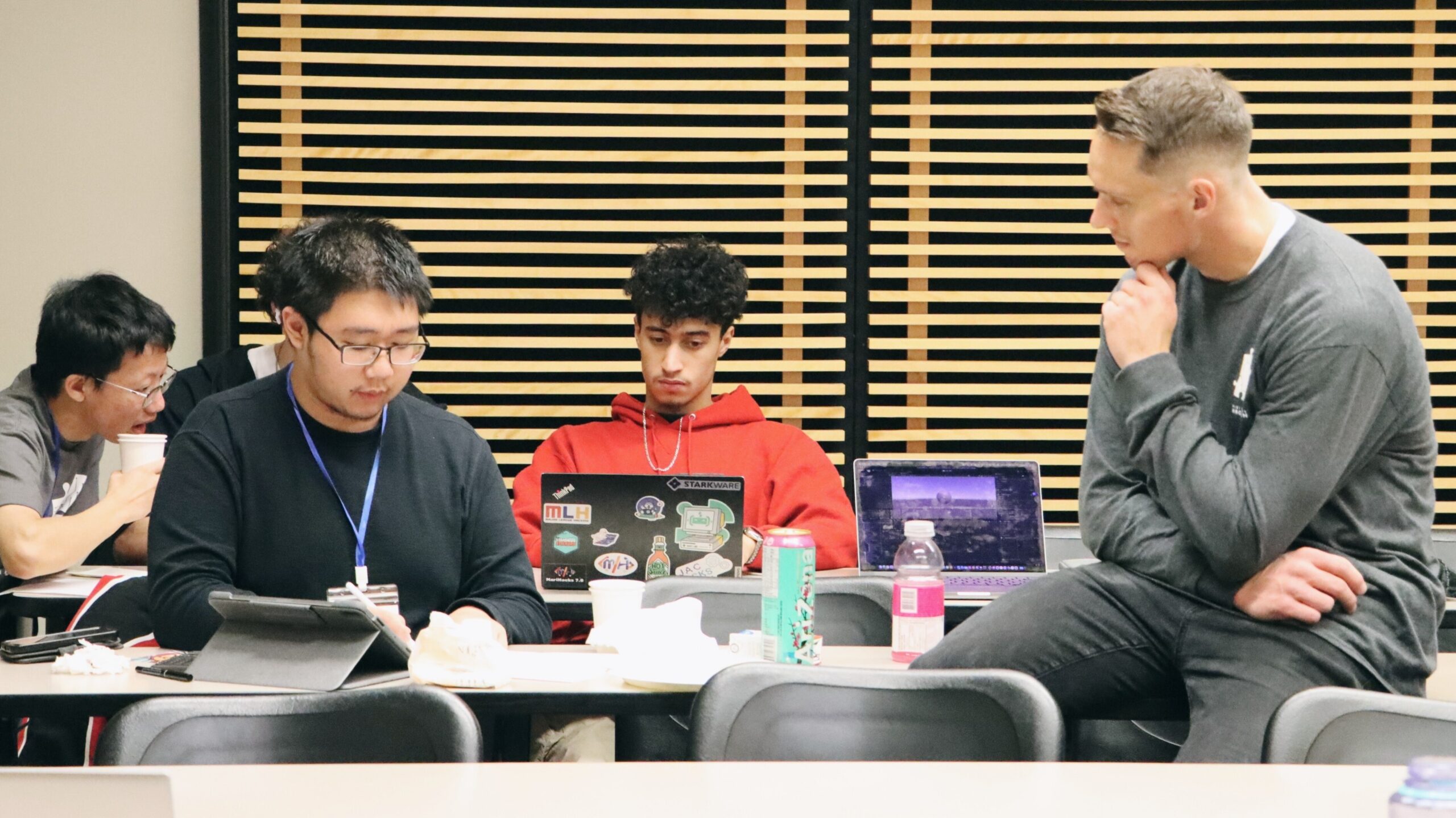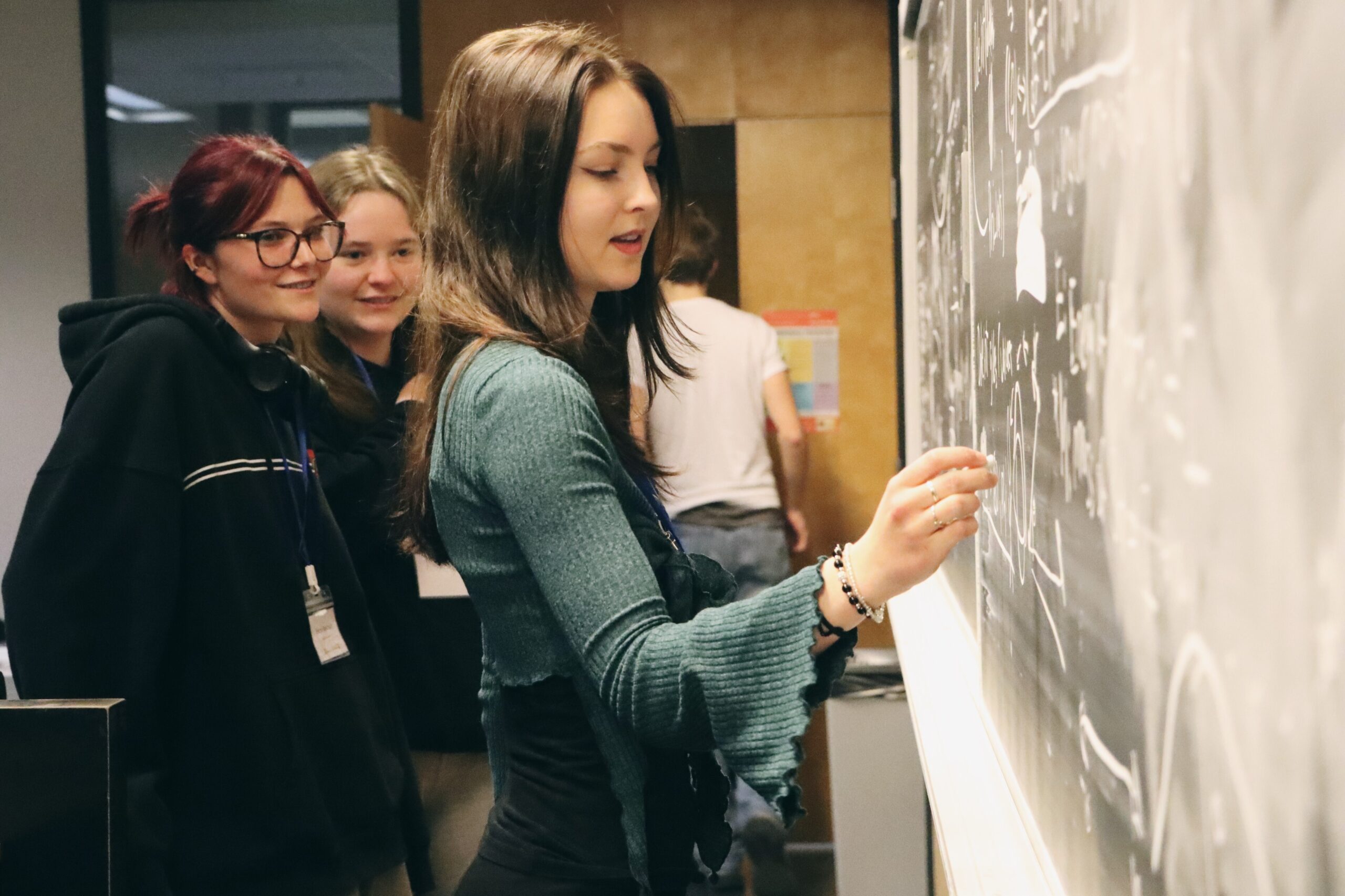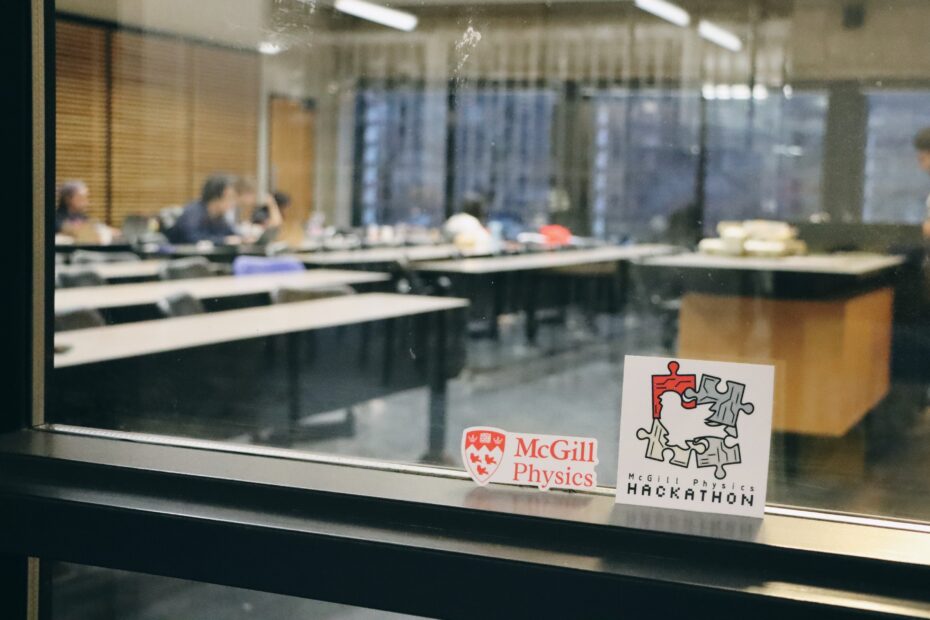An abridged version of this article was published in print on November 27, 2024.
Protecting the Earth from asteroids? Modelling how light behaves around a black hole? From November 15 to 17, the ninth edition of the McGill Physics Hackathon saw hundreds of young STEM enthusiasts congregate at McGill’s downtown campus, from high schoolers to graduate students. Their common goal? “Hacking” their personal projects in physics and adjacent subjects and sharing them with their peers in the STEM student community.
Over a period of 24 hours spaced across three days, teams of two to five students worked tirelessly to bring their visions to fruition. Luca and Jeremy counted as two of four CEGEP participants from John Abbott College working on coding a soccer shooting game. Their team’s goal was an intriguing twist on a classic game: kicking a soccer ball into a net, given that the ball’s flight is realistically influenced by drag.
“We’re trying to incorporate air resistance and other physical parameters into our project,” Luca explained to the Daily. “We’re using vectors to model the movement of objects through air.”
Roadblocks for their project were numerous, noted Jeremy, although he observed that overcoming such obstacles is what makes coding so satisfying. “There’s been quite a few moments where we’ve thought to ourselves: ‘I hate coding,’ only for everything to work out in the end.”
An open mind is one of the qualities that Dr. Kim Metera, one of the Hackathon organizers and undergraduate advisor for physics students at McGill, hopes to instill in participants. “People will have created something and taught themselves something, regardless of whether they’ve finished their project or not,” she observed. “The Hackathon is a chance to create something new, to hang out and collaborate with friends.”
Jointly organized by the McGill Department of Physics and the Trottier Space Institute (TSI), the McGill Physics Hackathon began in the mid-2010s and happens annually in November. For most of its history, the event only spanned a single day, and participant numbers figured below the 100 mark. This year’s Hackathon was special in two ways. First, a drastic increase in sponsorships allowed Hackathon organizers to host participants for a full weekend. Second, this year’s participant numbers broke a new in-person record at over 170 total participants.
To see this year’s Hackathon kick off on such a spectacular high note was a highlight for Catherine Boisvert, lead organizer and PhD candidate in the Department of Physics.
“During the opening ceremony, when we were onstage in the [Trottier] auditorium looking at all the participants and the sponsors,” she described, “I was listening to all the speakers and thought to myself: ‘Wow, this is happening. It all came together.’”

Hacking and Learning
For Luca, the Hackathon’s 24-hour deadline was a necessary creative constraint to push participants out of their comfort zones and experiment more. “It’s a really great learning environment to develop programming skills,” he said, “having that sort of stimulus to learn and grow and start coding. [The time limit] gives you an incentive.”
During the Hackathon, students could consult mentors whenever they encountered roadblocks in their code. Consisting of graduate students and other specialist volunteers, mentors played a central role in the problem-solving process. Their presence ensured that despite the time limit of 24 hours, participants would receive the necessary support to complete their projects. Hannah Fronenberg, PhD candidate and mentor, described the mentoring process as highly “dynamic.”
“You mostly just get here, start going around and meet teams — you either help them get started with their projects or help them overcome hurdles. These might be physics conceptual challenges or computational problems.” She noted that one might be “helping out with a relativity problem” before transitioning in quick succession to “debugging,” then “helping in fleshing out an algorithm.”
Sometimes, it is less a matter of teaching new knowledge and more of guiding someone toward understanding they already possess the sufficient know-how. “A lot of people have knowledge they aren’t aware they have,” recounted Dr. Stephan O’Brien, organizer and TSI Computing Fellow. “There was a group who was working on Javascript and Python who suddenly realized how to put their problem together. It’s the “eureka” moment, when it all clicks — that’s the really satisfying part.”
Hackathons provide an educational setting that fills in the many gaps that are frequently overlooked in traditional classroom settings. A 2024 literature review found that hackathons are effective at “enhancing collaboration and teamwork, providing hands-on learning experiences for workplace skills, facilitating skill transferability across sectors, and promoting student motivation and engagement.” Flexibility, awareness of one’s strengths and shortcomings, and an ability to collaborate on hands-on projects are skills that are useful in any career path, regardless of one’s field of study.
Understanding one’s intellectual shortcomings is also an integral part of the scientific process, Dr. Metera pointed out. “Research is about making mistakes. You try something, you make a mistake, you stumble and try something new, then you’ll make a new mistake! Everyone — even the most seasoned researchers — makes mistakes. You should collaborate; don’t do it by yourself.” She recalled an anecdote to illustrate her point: “There was a professor in a university in Germany who once said that “we’re here to learn, not to know.” Because no one truly knows what they’re doing!”

Forging Communities In Physics
Beyond the tinkering and the problem-solving, the Hackathon allowed participants to mingle with fellow STEM enthusiasts. Such events are crucial to fostering community among youth interested in physics and other areas of STEM and connecting them with the wider academic and industrial world.
The Hackathon aimed to prove that physics is not just a science. It is also a way of connecting and uniting people with shared passions. For Dr. O’Brien, physics was a method of self-expression in his youth. “I’m dyslexic, so I struggled a lot with languages,” he recalled. “In primary school, I gravitated toward math since math was a language that I could understand well. My disability makes math and the natural sciences more intuitive for me, and it’s what drew me toward those fields.”
Boisvert commented that she was “a bit of a late bloomer — I’m not the stereotypical kid who looked at the stars when they were ten.” She mentioned that her interest in science outreach began in her teenage years: “My high school was very much into STEM but didn’t necessarily highlight pursuing physics as a career, so I wanted people to get interested in physics.”
One of Boisvert’s driving goals is to bridge the gender gap in physics. “We have a lower percentage of women in physics, and in particular in condensed matter, which is the field I work in. So it’s important for me to promote physics, especially to women and minorities who are interested in studying the subject.”
Community, in particular the connection between older and younger generations, is a core element of the Hackathon. PhD student Regan Ross noted that “we also have a good department in terms of volunteers,” adding that one of his most “rewarding experiences is seeing people who come back.” Many past participants have returned to serve as either volunteers or mentors and help future generations of students experience the magic of the Hackathon.
Boisvert also took the time to extend her gratitude to the Hackathon’s volunteers: “We had an amazing team of volunteers and mentors and judges — sponsors, students, who have gone to the Hackathon before and who are working in their free time to make this happen. Volunteers who set up the venue, mentors who help with the physics and the coding. If there’s one thing to highlight, it’s that we couldn’t do anything on this scale without our volunteers.”

Inspiration Runs Both Ways
For Ross, seeing the passion of participants toiling away at a problem was the most inspiring aspect of the Hackathon. “If you walk into any of those rooms now,” he remarked while pointing at a series of doors, “you’ll see people working hard. It’s some otherworldly kind of dedication to come here during the weekend.”
When asked what he would say to youth who want to get into physics or other areas of STEM but aren’t sure they’re up to the challenge, Ross advised that “it’s hard to be good at anything. There are some basic skills needed in STEM,” he continued, “but it isn’t necessarily more challenging than other fields like the arts. For instance, I can write, but I’m not the best writer. If you’re interested in tinkering — taking things apart, putting them back together — then you’re already halfway there.”
Boisvert corroborated Ross’s sentiment, emphasizing the importance of contacting people in the fields you want to pursue. “If you’re interested, ask your teachers [or] your friends if they know someone in that area. People in science love to talk about their work. Don’t be afraid to reach out!”
Working at one’s own pace, rather than trying to emulate others, was an element which both Fronenberg and Dr. O’Brien underlined. Neither could have seen themselves doing a Hackathon during their high school or undergraduate years. Fronenberg, who now works on computational problems in cosmology, noted that she struggled in math during her childhood. “I only really got interested in science in high school,” she said, “once I built more confidence and did a lot of bridging [in mathematics] to get caught up. Which is one of the problems a lot of people face: if you’re bad at math, you’re drawn away from a lot of STEM fields like physics and engineering.” She went on to remark, “I really only started serious coding in grad school. I couldn’t imagine myself doing any of this in high school.”
Sergei Shilin, Hackathon mentor and co-founder of Blymp, highlighted passion as the primary key to success: “Follow your passions, the interests that will elevate you to the heights that it won’t bring anyone else. If there are two people in the same field … the person who has more passion will be the one who’s ahead in ten years’ time.”
